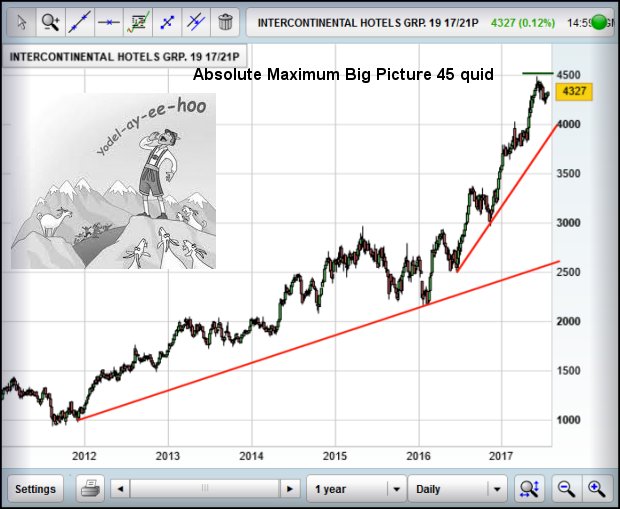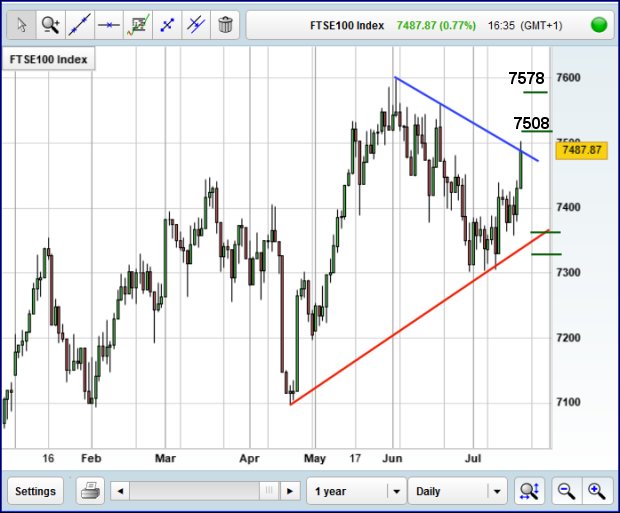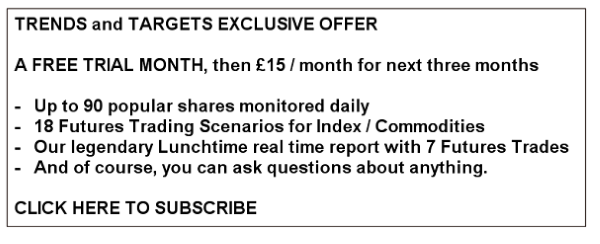FTSE 100 hits important number
21st July 2017 10:21
Dow Jones and S&P 500
The job of being a goatherd, high on a hill, is fraught with danger and loneliness, along with the ever-present echo of that Mary Poppins woman singing her heart out.
And, as always, nearing the top of a hill, a whimsical goatherd's thought turns to the markets... We let something slip the other day when examining the results produced against both the Dow Jones and the S&P 500.
Each index is approaching an uncomfortable point for us, that exquisite moment when we run out of big picture numbers as the price gets to the top of its particular hill.
Historically, both the Dow & S&P 500 have tended to play fair as they encroach on these perfect moments in time, either choosing to skip above the awkward number - something the S&P 500 has 'form' for - or retreating in a panic such as witnessed recently with the Dow and its mystery 200-point droop on 18 July.
We generally call these levels "stutter points", areas in the movement table where a market will generally be forced to fluff around while generating impetus for the next movement. There is often a lot of truth in the saying, "it's got to go down before it goes up" but this time the problem is a little more vivid.
If the S&P exceeds 2,502, we literally run out of numbers, whereas the Dow needs to better 22,129 to send our software into meltdown. When we realised the US markets were approaching this critical level, about the only advice available was to suggest "go short and wait - with a tight stop".
To dwell on the S&P first, if it approaches 2,502 (in fact, it's already pretty damned close at 2,479) our proposal suggests a short position with a stop as tight as you want. As for the drop target, 2,425 makes a lot of visual sense but we're almost guessing if we rely on the visual impression from a chart!
The reasoning which justifies a tight stop - say 2,505 - is if we're wrong and the index makes it above 2,502, a bold new trend is developing, one which we're ill-equipped to map (currently).
The Dow Jones is a slightly different kettle of fish. We exhaust our movement table above 22,129 but would suggest a wider stop, perhaps just above 22,200, as this index has a plethora of opening "gaps" which foul our calculations.
In terms of drop targets, the visuals suggest somewhere around 19,500 should prove about right. Or even 17,500! As with the S&P 500, we're guessing as absolutely nothing currently indicates such a plunge other than our software throwing a strop above 22,129 points.
So, we've presented some pretty attractive drop levels, it would be a shame if we didn't permit reality to intrude. While we eschew "fundamentals" and "technicals", it'd be silly to expect the markets to plunge without cause.
We anticipate the indices approaching our target levels and essentially mucking around for a while until a sufficient excuse appears to justify a drop.
Isn't it nice to know the indices are poised, awaiting some politician saying or doing something stupid? Perhaps even now, the politician is high on a hill, amorously chasing a goat while a photographer lurks in a bush.
There's also the risk nothing actually happens to justify calamity and, instead, we'll experience a few months of small movements which, when added together, generate sufficient oomph for a new upward trend.
If the markets were a share, we'd be confident some degree of rewind is coming but, even then, sometimes incredible patience is required.
The chart below is for , a share we monitor privately for clients. We had a big picture target of 4,500p, something it achieved fairly recently. Since then, the price has neither beaten our 45 quid nor collapsed.
We think it will drop, if only to generate future strength. But the share isn't really doing anything other than messing around between 4,200p and 4,500p. Perhaps this shall prove to be the fate awaiting the Dow and the S&P.
Our money is on the goat.

FTSE 100 (FTSE:UKX)
Now we've let the cat out the bag above with an expected calamity, which might not happen, how's the politically poisoned looking?
Oddly, it doesn't entirely stink, as above 7,495 looks capable of an astoundingly useless 7,508 points.
What will really interest us comes if 7,508 bettered, due to a new tier of numbers entering the fray, which makes a secondary upper target of 7,578 points pretty hard to avoid.
If triggered, the index requires to slither below 7,393 to utterly cancel the growth potential, quite a wide stop we admit, but when we refine the numbers, the tightest comes in at 7,425 points.
So what happens if 7,425 breaks?
It looks like 7,380 becomes possible, perhaps even 7,337 points as a secondary.
We're not entirely comfortable with these drop potentials and would submit 7,400 as a safer drop trigger.
Have a good weekend.


Alistair Strang has led high-profile and "top secret" software projects since the late 1970s and won the original John Logie Baird Award for inventors and innovators. After the financial crash, he wanted to know "how it worked" with a view to mimicking existing trading formulas and predicting what was coming next. His results speak for themselves as he continually refines the methodology.
Alistair Strang is a freelance contributor and not a direct employee of Interactive Investor. All correspondence is with Alistair Strang, who for these purposes is deemed a third-party supplier. Buying, selling and investing in shares is not without risk. Market and company movement will affect your performance and you may get back less than you invest. Neither Alistair Strang, Shareprice, or Interactive Investor will be responsible for any losses that may be incurred as a result of following a trading idea.
This article is for information and discussion purposes only and does not form a recommendation to invest or otherwise. The value of an investment may fall. The investments referred to in this article may not be suitable for all investors, and if in doubt, an investor should seek advice from a qualified investment adviser.
Editor's Picks